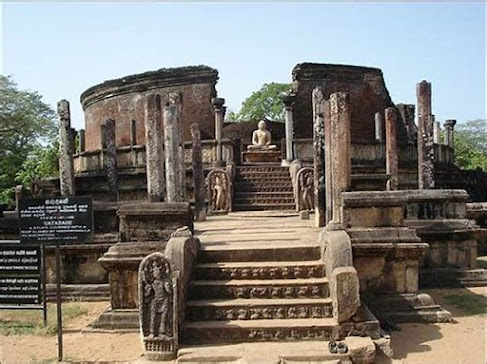parakrama samudra
One of the most striking features in Polonnaruwa is the vast Parakrama Samudra (Sea of Parakramabahu), an irrigation tank built, as the name indicates by King Parakramabahu the Great. This was his largest irrigation project and covers an area of more than 15 Km2.The dam (or bund, as it is known in Sri Lanka, is almost 14 Km long and 12 metres high.
The waters of the Parakrama Samudraya circle the ancient city and its environs, and in ancient times served as a moat against invading armies. An intricate network of irrigation canals supplied water from this reservoir to surrounding paddy fields, ensuring that agricultural production could be carried out year-round. The hitherto rain-fed agricultural practices were transformed, and Polonnaruwa became the rice growing capital of ancient Lanka.
The Dipuyyana (Island Garden) is on the promontory by the rest house. When King Parakramabahu had built his vast lake, he selected this lovely spot for a royal garden. Later King Nissankamalla liked it so much that he built his palace and council chambers there.
The Vatadage
This circular relic house possesses an elegance and beauty that is rare even in ancient Sri Lanka. In line with the outer circle of stone pillars is a tastefully ornamented screen wall patterned with four petaled flowers.
The flights of access stairs at the cardinal points are of stone and are beautifully carved. At the head of each flight is a Buddha statue in stone. The shrine is lavished with moonstones., guard stones and sculptured writings.
The shrine, like all dagobas in Sri Lanka, is oriented towards the cardinal points – north, south, east and west. Four Buddha statues face outwards, with their backs to the dagaba
Nssanka Lata Mandapaya
Gal Vihare
The Gal Viharaya is a cluster of carved Buddha images, which would have formed part of an extensive monastery on this site. Four separate images of the Buddha are carved from one long slab of granite, a feat of artistry. The Buddha rock sculptures at the Gal Vihare are considered masterpieces of Sri Lankan Buddhist art, and were commissioned by King Parakramabahu I.
The first sculpture is a seated Buddha image in a deep meditation, on a throne decorated with lions and thunderbolts and behind the Buddha is a halo. The statue is one of the most impressive examples of Sri Lanka’s sculpture.The next sculpture is inside a cave carved out of solid rock. The seated Buddha is protected by an umbrella. Between the cave and the tall standing figure is a large inscription of Parakramabahu, which records in detail his struggle to unite the Buddhist order, and sets out the reformed rules of conduct.
The finest of the images – the standing figure is twenty three feet high (7 metres) with crossed arms. The carving of the serene face is extremely sensitive, and the relaxed, elegant execution of the body and drapery distinguishes this figure as one of the masterpieces of Sri Lankan art.
The immense figure of recumbent Buddha measures 46 ft (14 metres). is the last sculpture in the group. The Buddha is lying down, at the final moment of his earthly life, entering Parinibbana, the state of supreme enlightenment. Here too the liquid flow of the robes over the body and the calm expression of the face are beautifully interpreted.








0 Comments